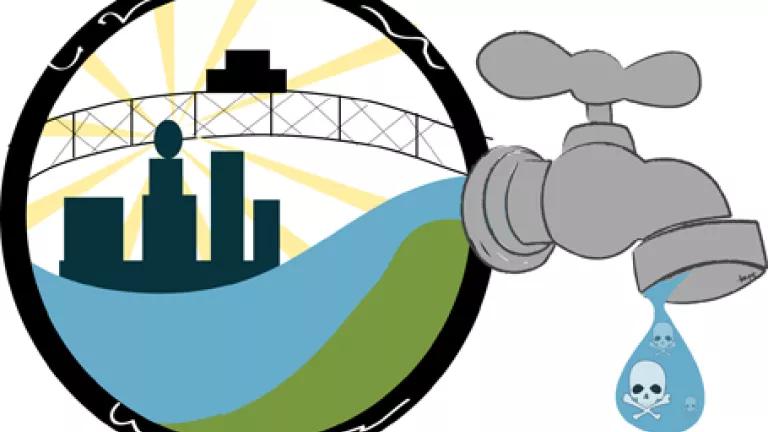When Water Hurts—In Flint and Beyond

When most of us think about water, we typically think about it as a source of replenishment and rejuvenation—a cool drink on a hot summer day, a warm shower after a long day at work. With most of the country's drinking water protected by the Safe Drinking Water Act, we expect that the water we use for our cooking, bathing, and drinking is safe for our families and ourselves. Clean, safe water is a right, not a luxury in this country.
When the people of Flint, Michigan wake up in the morning, however, the water from their taps is no longer a source of renewal and comfort. Instead, drinking water has become a source of fear, distrust, and anxiety. Their water is a source of dangerous amounts of lead.
There is no safe level of lead exposure. It is a toxic at any level.
Lead has been shown to harm both children and adults, with kids facing much more severe health consequences from even low levels of exposure.
For adults, high levels of lead exposure have been shown to increase blood pressure (Fioresi, 2014; Zota, 2013), anemia (Adams, 2012; Shah, 2010), and kidney disease (Pollack, 2015; Sommar, 2013; Navas-Acien, 2009). Long-term exposures have been associated with weakness in extremities like the fingers, ankles, and wrists (CDC, 2007).
Even when children ingest the same amount of lead as adults, their bodies work differently, which can make them even more susceptible to the short and long-term effects of lead (Sanders, 2009). Lead exposure during pregnancy has been associated with adverse outcomes such as preterm delivery, reduced birth weight, birth length, and head circumference (Taylor, 2015) Lead exposure in childhood has also been linked to decreased IQ (Lanphear, 2005), behavioral problems (Eubig, 2010), and neuropsychological function (Surkan, 2007).
Lead can also accumulate in our bodies over time. When we are exposed to lead, some of it will enter our bloodstream, where it passes through some of our soft organs like our kidneys, liver, and brain. It can then be deposited in our bones, where it can be stored for decades, being released during times of bodily stress, such as those faced during pregnancy, aging, or illness (Hu, 1998).
The lead crisis in Flint, MI demonstrates the public health risks posed by aging infrastructure and lead pipes.
The people of Flint are particularly vulnerable to the harms associated with lead. According to the 2010 United States Census, 8 percent of Flint's nearly 100,000 residents are under the age of 5. 27.3 percent are under the age of 18. Over 40% of the population lives below the poverty line, 20% of the population lives with a disability, and over 60% of the population is non-white. Additionally, according to the Michigan Department of Health and Human Services health statistics data, Genesee County (where Flint is located) has higher rates of deaths from kidney and cardiovascular disease than Michigan or the United States as a whole.
|
Table 1. Mortality rates for kidney and cardiovascular disease (per 100,000) in 2013 (Michigan Department of Health and Human Services and the National Center for Health Statistics) |
|||
|
|
Genesee County |
Michigan |
United States |
|
Kidney disease |
21.6 |
13.9 |
14.9 |
|
Cardiovascular disease |
228.9 |
199.9 |
193.3 |
The situation in Flint is likely of a different magnitude than what we would face in other parts of the county, but it's a powerful example of how urgently we need to fix infrastructure across the country. Communities with lead service lines and older housing stocks could also be at risk for drinking water contamination by lead.
Only tests can determine if water has lead. You cannot see, taste, or smell it.
Certain households are at greater risk for having lead in drinking water, including homes with lead pipes or lead soldered pipes. Homes built before 1930 may have lead pipes (CDC, 2007 at p. 314). Also, households in areas with lead pipes as part of the water infrastructure (lead service lines) and/or in areas with acidic or "soft" water, are more likely to have lead.
If lead has been detected in your drinking water or in the drinking water in your area, here are a few ways to minimize lead exposure for your household:
- Before using your water for cooking or drinking—especially if it has been sitting for a long period of time—flush your water system by running cold water through your tap until the water is cold to the touch. Water that has been sitting for a long time could be room temperature, even on the cold setting. This could take several minutes.
- Place filters on your taps that are certified to remove lead from the water.
- Use bottled water for drinking, cooking, and preparing formula.
- Search your home for other possible sources of lead (e.g., leaded paint) and minimize all of your possible exposures to lead.
These measures can help reduce your exposure to lead. But we shouldn't have to intervene, household by household, to make sure our drinking water is healthy for us to consume. The people of Flint, and all of us, should be able to turn on the tap at anytime, and feel confident that the water coming out of our taps is clean and safe.



